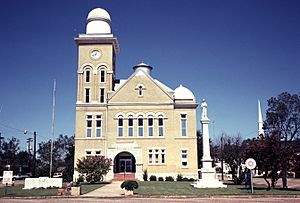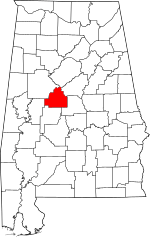Bibb County, Alabama facts for kids
Quick facts for kids
Bibb County
|
|
|---|---|

Bibb County Courthouse and Confederate monument in Centreville
|
|

Location within the U.S. state of Alabama
|
|
 Alabama's location within the U.S. |
|
| Country | |
| State | |
| Founded | February 7, 1818 |
| Named for | William W. Bibb |
| Seat | Centreville |
| Largest city | Brent |
| Area | |
| • Total | 626 sq mi (1,620 km2) |
| • Land | 623 sq mi (1,610 km2) |
| • Water | 3.6 sq mi (9 km2) 0.6% |
| Population
(2020)
|
|
| • Total | 22,293 |
| • Estimate
(2023)
|
21,868 |
| • Density | 35.612/sq mi (13.750/km2) |
| Time zone | UTC−6 (Central) |
| • Summer (DST) | UTC−5 (CDT) |
| Congressional district | 6th |
|
|
Bibb County is a county located in the central part of Alabama, a state in the United States. It is part of the larger Birmingham, AL Metropolitan Statistical Area. This means it's connected to the bigger city area.
As of the 2020 census, about 22,293 people lived in Bibb County. The main town and county seat is Centreville. The county is named after William W. Bibb, who was the first Governor of Alabama. He was also governor of the Alabama Territory before it became a state.
Bibb County is known as a "dry county." This means there are special rules about selling alcoholic drinks. However, some towns within the county, like Woodstock, West Blocton, Centreville, and Brent, have decided to allow alcohol sales. The main courthouse for Bibb County is in Centreville.
Contents
History
Bibb County was first created on February 7, 1818. It was originally called Cahawba County. The name came from the Cahaba River, which flows through the area. The word "Cahawba" comes from the Choctaw language and means "water above."
Later, on December 4, 1820, the county's name was changed to Bibb County. This was done to honor William W. Bibb, who was a very important person in Alabama's early history.
Geography
Bibb County covers a total area of about 626 square miles. Most of this area, about 623 square miles, is land. The rest, about 3.6 square miles, is water.
Neighboring Counties
Bibb County shares its borders with several other counties:
- Jefferson County to the north
- Shelby County to the northeast
- Chilton County to the southeast
- Perry County to the southwest
- Hale County to the southwest
- Tuscaloosa County to the northwest
Protected Natural Areas
The county is home to some important natural places:
- Cahaba River National Wildlife Refuge: A special area to protect wildlife along the Cahaba River.
- Talladega National Forest (part): A large forest that stretches into Bibb County.
Unique Plants
Bibb County is special because it has several plant species that grow only there and nowhere else in the world. These are called endemic species. Some examples include:
- Xyris spathifolia
- Dalea cahaba
- Spigelia alabamensis
- Lithospermum decipiens
- Solanum pumilum
- Castilleja kraliana
- Erigeron dolomiticola
- Liatris oligocephala
- Silphium glutinosum
Transportation
Bibb County has several important roads and a railway line.
Main Roads
 U.S. Highway 11
U.S. Highway 11 U.S. Highway 82
U.S. Highway 82 State Route 5
State Route 5 State Route 25
State Route 25 State Route 58
State Route 58 State Route 139
State Route 139 State Route 209
State Route 209 State Route 219
State Route 219
Railways
- Norfolk Southern Railway
Population Information
| Historical population | |||
|---|---|---|---|
| Census | Pop. | %± | |
| 1820 | 3,676 | — | |
| 1830 | 6,306 | 71.5% | |
| 1840 | 8,284 | 31.4% | |
| 1850 | 9,969 | 20.3% | |
| 1860 | 11,894 | 19.3% | |
| 1870 | 7,469 | −37.2% | |
| 1880 | 9,487 | 27.0% | |
| 1890 | 13,824 | 45.7% | |
| 1900 | 18,498 | 33.8% | |
| 1910 | 22,791 | 23.2% | |
| 1920 | 23,144 | 1.5% | |
| 1930 | 20,780 | −10.2% | |
| 1940 | 20,155 | −3.0% | |
| 1950 | 17,987 | −10.8% | |
| 1960 | 14,357 | −20.2% | |
| 1970 | 13,812 | −3.8% | |
| 1980 | 15,723 | 13.8% | |
| 1990 | 16,576 | 5.4% | |
| 2000 | 20,826 | 25.6% | |
| 2010 | 22,915 | 10.0% | |
| 2020 | 22,293 | −2.7% | |
| 2023 (est.) | 21,868 | −4.6% | |
| U.S. Decennial Census 1790–1960 1900–1990 1990–2000 2010–2020 |
|||
2020 Census
The 2020 United States census counted 22,293 people living in Bibb County. There were 6,891 households and 4,789 families.
Here's a look at the different groups of people living in Bibb County in 2020:
| Race | Number of People | Percentage |
|---|---|---|
| White (not Hispanic) | 16,442 | 73.75% |
| Black or African American (not Hispanic) | 4,390 | 19.69% |
| Native American | 39 | 0.17% |
| Asian | 26 | 0.12% |
| Pacific Islander | 9 | 0.04% |
| Other/Mixed | 647 | 2.9% |
| Hispanic or Latino | 740 | 3.32% |
Population Changes Over Time
From 1920 to 1970, the number of people living in Bibb County went down quite a bit. During this time, many African Americans moved to cities in the northern and western parts of the U.S. This big movement was called the Great Migration. They moved to find better opportunities and to escape unfair treatment.
Education
Bibb County has one main public school district. About 3,100 students attend public schools from kindergarten through 12th grade in the county.
School Districts
The main school district is:
- Bibb County School District
Communities
Bibb County has several towns and communities.
Cities
- Brent
- Centreville (This is the county seat, where the main government offices are.)
Towns
- Vance (Part of this town is also in Tuscaloosa County)
- West Blocton
- Woodstock (Part of this town is also in Tuscaloosa County)
Unincorporated Communities
These are smaller communities that are not officially part of a city or town:
Ghost Towns
- Cadle (A ghost town is a place where most people have left, and it's no longer an active community.)
Places to Visit
Bibb County offers some interesting places to explore:
- Talladega National Forest: This large forest is managed by the United States Forestry Service. It's a great place for outdoor activities.
- Cahaba River: A section of this river runs through Bibb County. Visitors come to see the special "Cahaba Lily" (scientific name: Hymenocallis coronaria), a unique flower that grows in the river.
See also
 In Spanish: Condado de Bibb (Alabama) para niños
In Spanish: Condado de Bibb (Alabama) para niños

